It’s no secret that market segmentation can increase the engagement rates of emails, blog posts, and sales pages.
In addition to increasing engagement rates, your messages hit closer to home and are in line with what your people want.
According to eMarketer, after implementing segmentation nearly 40% of marketers experienced higher email open rates while 24% experienced increased revenue.
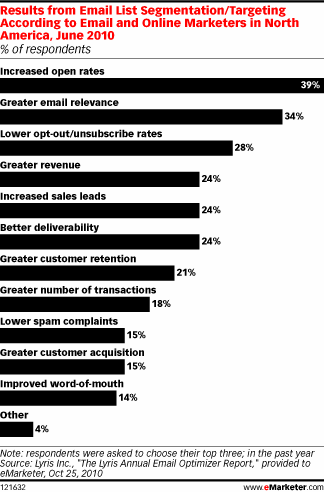
That’s a win.
The smaller your customer segments, the better you’re able to target your message to the person receiving it.
Though there’s no denying the effectiveness of market segmentation, many people fail to implement it because of perceived complexity.
You have the potential to create dozens of segments and hundreds of messages. That’s by no means necessary.
What is market segmentation?
Market segmentation is the process of dividing a market of potential customers into groups or segments based on different characteristics important to you. The people grouped into segments share characteristics and respond similarly to the messages you send.
In this post, we’ll focus on the benefits of market segmentation, how to segment new leads, and simple strategies to increase revenue from segmented users.
You may also like:
Levels of Measurement: Nominal, Ordinal, Interval, and Ratio Scales
Target Market Examples, Definition, and Finding the Right one
The 11 Best Free YouTube to MP3 Converters
Behavioral Segmentation Defined + How to Use it for Explosive Results
7 Data Collection Methods for Qualitative and Quantitative Data
Best YouTube Downloaders of the Year
Top 13 Demographic Survey Questions you Should be Using
15 Best Landing Page Builder Software
Why is market segmentation so important?
Before we jump into why it matters, let’s look at why ignoring it is doing more harm than good.
Think about how you interact with other brands. If you’re like me, you visit the website, consume great content, and maybe subscribe to their mailing list.
Over the next few days or weeks, they send you through an email marketing campaign to introduce you to their brand and get you to buy something.
As you embark on their email marketing campaign, a carefully orchestrated journey awaits, introducing their brand and enticing you to make a purchase.
Immersive and personalized emails are crafted to cultivate trust, delivering valuable insights and showcasing the unparalleled benefits of their products or services.
Throughout this tailored email experience, they artfully nurture your interest, expertly guiding you along the buyer’s journey toward becoming a delighted customer.
You ignore half of those messages and only pay attention to the ones that matter to you. Sometimes you buy and sometimes you don’t. A good percentage of the time, you buy because you need their product despite their poor attempts of selling you.
This is unsegmented marketing at its finest. You see messages that don’t matter for products you don’t care about. If it goes on long enough you’ll eventually unsubscribe and move on with your life.
At KyLeads, we can’t afford to throw our marketing dollars away without seeing some sort of return. I’m sure you feel the same way.
Your prospect isn’t some basic B – she’s your mother. Okay, totally stole that quote from Ogilvy but it’s oh so true.
Nobody likes feeling like they’re just another number, but when you get to a certain level in your business, how do you help your ideal client or customer feel like you’re talking directly to them? Segmentation. Because segmentation breeds specificity and specificity sells.
Segmented email campaigns have an open rate that is 14.32% higher than non-segmented campaigns. Click-throughs are 100.95% higher than non-segmented campaigns. The stats are speaking, are you listening?
The clients I work with that use segmentation see higher open rates, lower unsubscribes, and higher conversions. They can get a bird’s eye view on exactly WHO comprises the majority of their customer base, and pivot their marketing to focus more on the most profitable segments of their audience.
The best part is when they use quizzes as a segmentation tool, leads don’t FEEL like they’re being segmented (nobody likes feeling segmented BTW).
Enter market segmentation and why it’s no longer optional.
Benefits of market segmentation
There are many benefits. I’ll touch on three.
More efficient – We live in an age where you can track almost everything. If you’re not measuring it then you can’t grow it. With marketing segmentation, you can track the effectiveness of each message for different segments of your audience.
Over time, you’ll discover the best ways to spend your money and achieve a positive return on investment.
More effective – which of the following messages would you respond better to?
- The ultimate guide to building muscle for men over forty
- The ultimate guide to building muscle
You may click on the second one out of general curiosity. If you’re a man over forty years old then the first one is almost guaranteed to pique your interest.
Once they click the first title and land on the page, they’ll be more receptive to everything there because it was made with them in mind. It would be a natural progression for them to buy what’s being sold or subscribe to a mailing list with more insights.
Better resource utilization –
Half the money I spend on advertising is wasted; the trouble is, I don’t know which half.
– John Wanamaker
I couldn’t have said it better myself. Ever since the first flyer was printed, it’s been a challenge to measure what’s working and what’s not.
Customer segmentation addresses this issue by sending your messages to people who’re receptive to it. With the example about building muscle, you know the people consuming the content are over forty.
With that information, you can also make other assumptions in line with that demographic group (more on demographics in a moment).
The result is using your limited resources in a way that’ll bring a higher ROI.
What are the types of market segmentation?
There are four broad types of customer segmentation. These can be further subdivided into as categories as you like but always use the following classifications as a guide.
Demographic Segmentation
- Income
- Religion
- Gender
- Education
- Occupation
- Marital Status
- etc.
Demographic segmentation is the simplest and by extension the most widely used type of market segmentation. Companies use it to create broad groupings of the population based on things such as age, sex, location, religion, family size, etc.
These are usually black and white groupings that give you a profile of whether or not someone has the ability to buy what you’re selling. For example, if you have a product for people 21 and older (like alcohol) then people under that age group are irrelevant to you.
Similarly, products targeted at men usually won’t be useful for women unless you’re marketing them as the perfect gift.
An example of how companies use demographic information would be the travel industry. The way and the people who a first-class ticket is marketed to are different from a coach ticket.
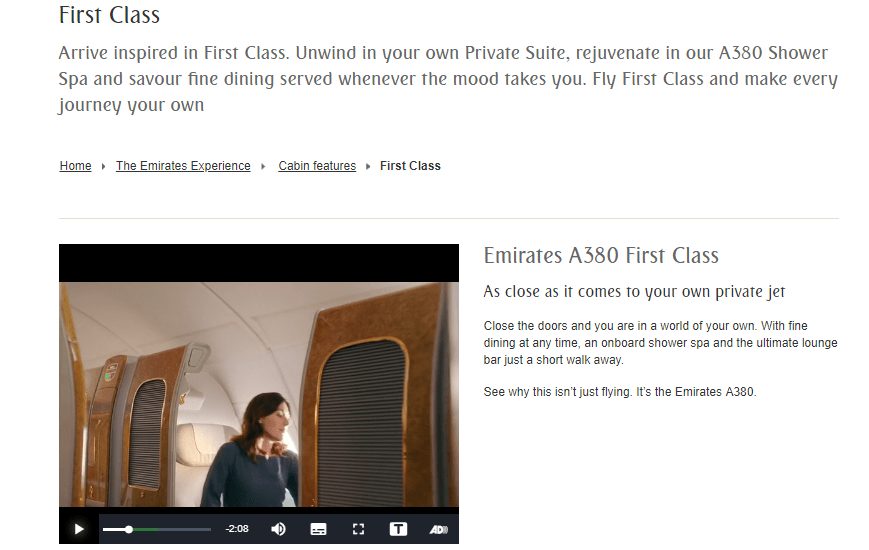 It emphasizes the comfort and luxury of first-class tickets.
It emphasizes the comfort and luxury of first-class tickets.

For economy class, they focus on the number of TV channels they have.
Behavioral Segmentation
- Loyalty
- Usage
- Occasions
- Special events
- Engagement
Behavioral segmentation taps into the way people make decisions over time or in response to stimuli. For example, the way a company markets during the holiday season and the deals available are different from the rest of the year. Discounts offers are strategized in a way that it may appeal to a certain segment of the market
They’re aware people are in a more receptive mood and may be willing to make larger purchases. Younger people and athletes prefer brands like Jordan and Air Max while the older generations prefer brands like New Balance.
At first glance, it may seem like a demographic difference. While that plays a part, it’s more about the way the customer behaves and perceives the brands.
Geographic Segmentation
- Country
- Region
- City
- Weather
- Population density
As the name implies, this type of market segmentation groups people based on their physical location. You may want to go this route because the needs of your customers differ from region to region.
For example, someone in a rural area wouldn’t need a subway but someone in a city would.
Geographic segmentation can also be used to offer specific deals to your potential customers. Lastly, you can use this type of segmentation to adapt the language and tone of your messages.
In Georgia, every soda is called coke until you ask a few clarifying questions. In Chicago, soda is referred to as pop.
Understanding these regional preferences can also help businesses tailor their customer interactions. For instance, a CRM software can store location-based data, allowing companies to personalize communication and offers based on geographic insights.

Psychographic Segmentation
- Lifestyle
- Opinions
- Attitudes
- Value
This type of segmentation is based on the lifestyle, interests, and activities of individuals that make up a customer segment.
Demographic segmentation tells you someone is an older male while psychographic segmentation tells you they go hiking on the weekends.
This is the type of segmentation that tells you what people do and why they buy. Psychographic segmentation is similar to behavioral segmentation but there’s a difference.
Behavioral segmentation tells us that this demographic group buys bamboo underwear. Psychographic segmentation tells us this demographic group buys bamboo underwear because it has a smaller carbon footprint and they’re environmentally conscious.
Lenovo partnered with Neustar, implemented market segmentation, and created personalized banners on their homepage that increased click-through rates by 30% and conversions by 40%.
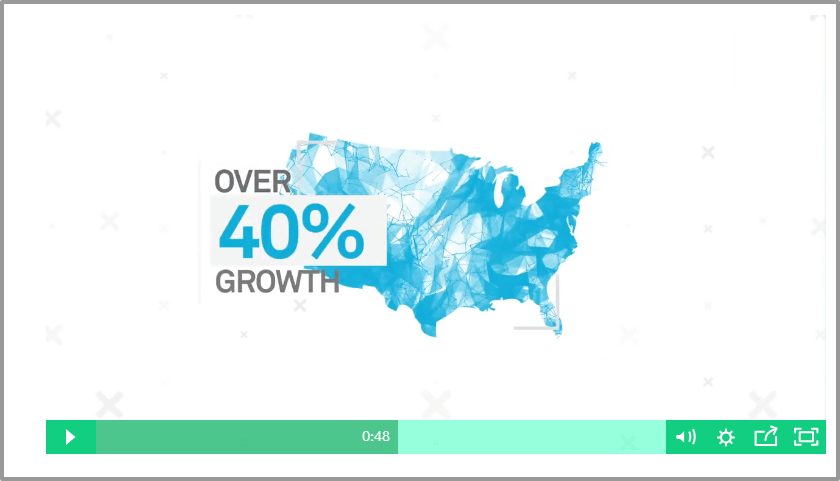
Firmographic segmentation
- Industry
- Annual revenue
- Company size
- Sales stage
- Performance
- Executive title
- Location
Firmographic segmentation is the process of analyzing and classifying B2B (business to business) audiences and customers based on similar characteristics that matter to your business. The way a firmographic grouping will look for one organization may be different than the way it looks for another organization.
Does that mean one company is correct with its firmographic segmentation and another one is wrong? No, it just means they have different KPIs (Key Performance Indicators). For example, a national brand may classify its prospects based on location and those locations are north, south, east, and west. A global brand may also classify based on location but their groups are North America, Europe, Africa, Asia, etc.
These are both forms of firmographic segmentation but vary widely.
Firmographic segmentation can affect the way you approach prospects, the information you push forward as benefits, and even the solutions being offered. For example, if you have an accounting solution that can serve small businesses and enterprise clients and help in easy payment of digital taxes you wouldn’t approach them the same way.
For the small business, you might run paid ads and work to get direct sign-ups.
When you’re running ads on Google, keeping an eye on your Google Ads KPIs is crucial. Things like how many people are clicking, how many are actually signing up, and how much it’s costing you can tell you a lot about what’s working and what needs tweaking.
Think of it as fine-tuning your approach based on real numbers, so you’re not just guessing but making your budget count.
For enterprise companies, you may focus on lead generation, demos, and tailoring the solution to meet their needs. Firmographic segmentation gives you insights to make those decisions.
Market segmentation vs customer segmentation
There’s a lot of confusion around market segmentation and customer segmentation because they’re so closely related. Many people use the terms interchangeably.
That’s a mistake because they’re two distinct disciplines.
Market segmentation, as I’ve stated earlier in this article is the process of dividing a market of potential customers into groups or segments based on different characteristics important to you. The operative phrase is “potential customers.”
Customer segmentation, on the other hand, is when you divide your current customers into discrete groups that are important to you.
An example of a customer segment could be people whose average cart value is more than $100. For a software company, with multiple pricing tiers, the segments could be tired which plan a customer is on.
Why does the distinction matter?
That’s a good question. The distinction matters because, with one, you’re assuming customer groups while the other uses concrete data gained from past behavior.
Market segmentation can be done before you ever have a customer. It’s an educated guess about who you want to serve and what kind of messages they’ll respond to.
Customer segmentation is done after you have customers and can identify characteristics different groups share.
Using the example of software, the first customer segmentation criteria may be what plan they’re on.
Going deeper, the software vendor could layer on information about the industry the customer is in, the way they’re using the tool, etc. Using those insights, they could market to the existing customer and encourage them to upgrade.
When to use customer segmentation and market segmentation
To put it simply, market segmentation is used for people who’re not yet customers. Customer segmentation is for people who’ve purchased from you at least once. You can also extend customer segmentation to your leads if you have enough information about them.
With that being said, the information you get to implement useful customer segments can also be used to inform your market segmentation efforts. You can tweak your marketing messages, landing pages, and even pricing to attract specific market segments.
It’s important to understand that none of this is static. As you get a deeper understanding of your target market, you should use take that information to improve other areas of your business. This constant feedback loop is how you refine your messaging and grow your business over time.
Implement market segmentation based on the following criteria
Email marketing segmentation and general market segmentation can be tricky because there are so many data points you can use.
It’s easy to get stuck in analysis mode when trying to decide what to focus on. Should you separate your audience into male and female or should you focus on where they live and their age?
The specific answer is that it depends on your business. If you’re selling athletic clothes, it makes sense to divide your audience into male and female.
When you’re selling online courses, those groupings don’t matter much. Though the specific segmentation path you follow will depend on your business, there are broad strokes you can take depending on whether you serve other businesses or consumers.
Navigating the labyrinth of Amazon AWS Certification Dumps can be as complex as mastering email marketing segmentation. Just as marketers grapple with countless data points, aspiring cloud professionals face a dizzying array of certification options.
Should you focus on Solutions Architect or DevOps Engineer? Is the Certified Cloud Practitioner the right starting point, or should you dive straight into the deep end with a specialty certification? The answer, much like in marketing segmentation, hinges on your unique career goals and the specific demands of your industry.
While the path to AWS mastery may seem daunting, there are overarching strategies you can employ, whether you’re an individual looking to boost your resume or a business aiming to upskill its workforce.
Ultimately, the key lies in aligning your chosen AWS certifications with your professional aspirations, much as a savvy marketer aligns segmentation strategies with business objectives.
B2C
Except professional consumers or prosumers, consumers are more sensitive to price and are more likely to make impulse decisions. Segmentation of these types of customers reflects their buying habits.
Gender
This is the most common and accessible segmentation method. Certain categories appeal to men more than women and vice versa.
For example, Ecommerce fashion websites are divided into men’s sections and women’s sections. Not only does this make sense from a practical perspective, but it also makes sense from a marketing perspective. It allows you to show visitors relevant products.

Michael Kors divides the website into men and women.
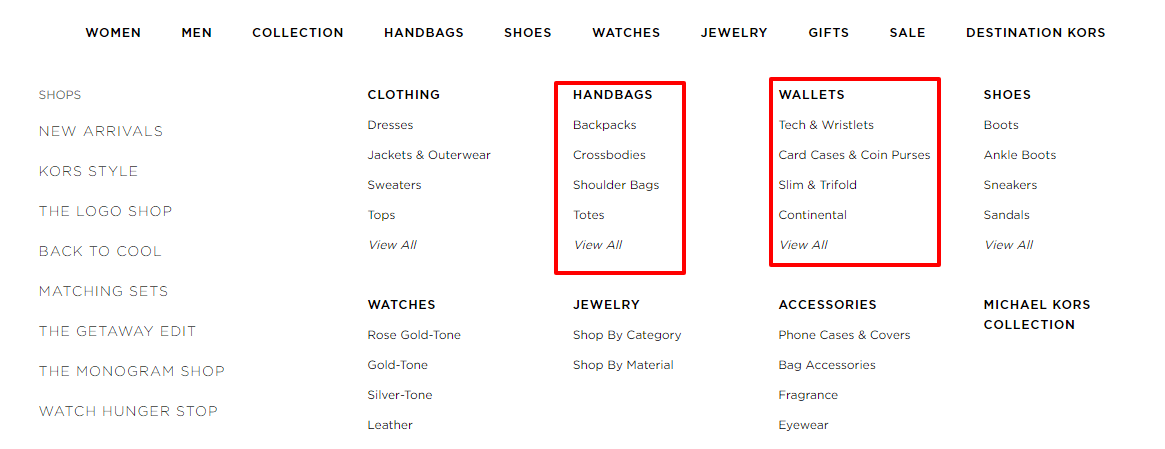
The women’s section contains handbags and specific language that would appeal to women.
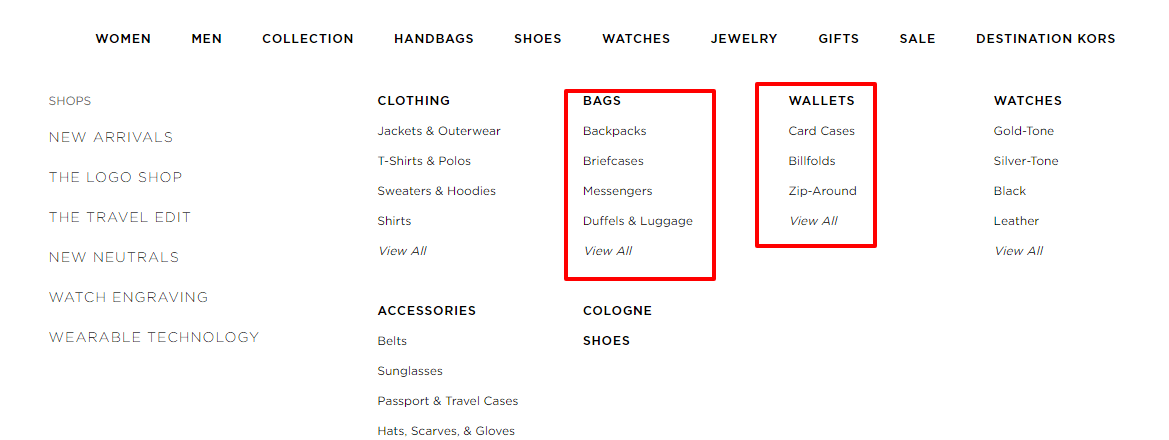
It does the same thing for men.
This is a simple example and many people reading this may think it’s a no-brainer. A lot of thought went into the phrasing of the menu labels. As a man, I have no idea what a continental or a slim & trifold is.
Moving on.
Geographic region
Geographic segmentation has the potential to deliver relevant messages. Consumers respond well to deals targeted at their specific location.
You can do this by sending messages with deals just for their city or even add a geotrigger to your website that mentions their region in your copy.
Interest
Retargeting your audience based on what they like is an effective strategy – especially when you have multiple products.
Someone with a general interest website that covers cooking, traveling, and parenting would have an issue delivering targeted messages. When they segment their audience into specific groups (more on how to do this later) they’re able to send messages that appeal to specific interests.
That could be an Ebook on parenting, courses on how to travel the world, a book with great recipes, or even a service that helps them book the best flights. The point is, you’re only sending messages they’ve expressed an interest in receiving.
You can also capitalize on interest segmentation if you have a single product. Anyone that visits your website is obviously interested in what you’re offering. Freshdesk took this route when I strolled through its website.
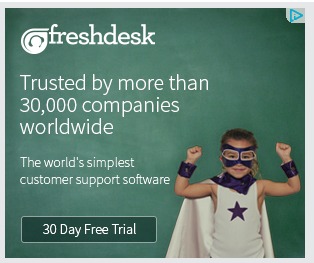
Age
Age alone may not be the best way to implement marketing segmentation. Coupled with one or more of the other segmentation methods, it’s a great way to further narrow down your potential customers.
Of course, if you have age-sensitive offers like alcohol then it’s a must.
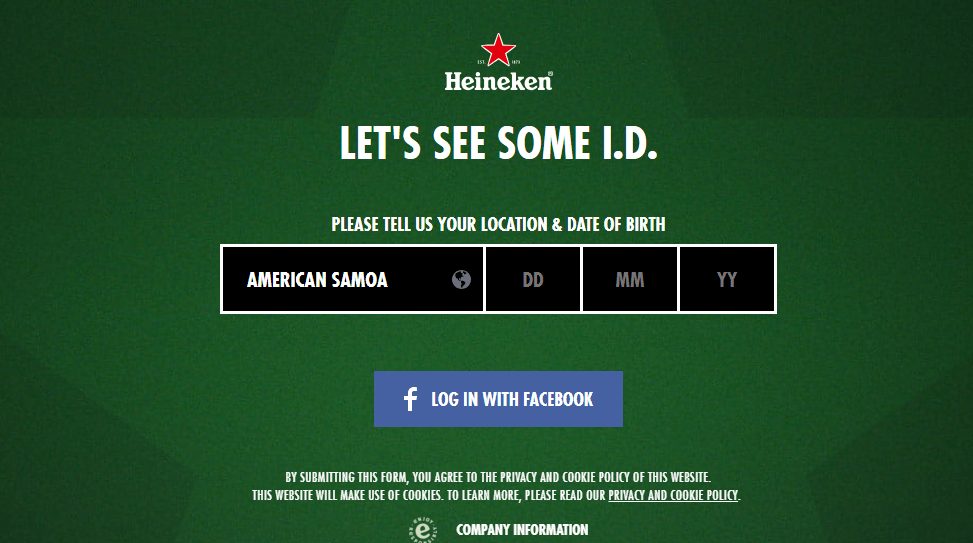
Coupled with their interests, segmentation based on age becomes powerful.
Purchase history
What have they purchased in the past and how long ago did they purchase it? This data will let you know what they’re interested in. Anyone can tell you what they like but the real truth is when they pay for it with cold hard cash.
Nissan launched a successful email marketing campaign that took into consideration when people purchased and what they purchased. It highlighted new products and important milestones like when their customers were due for an oil change.
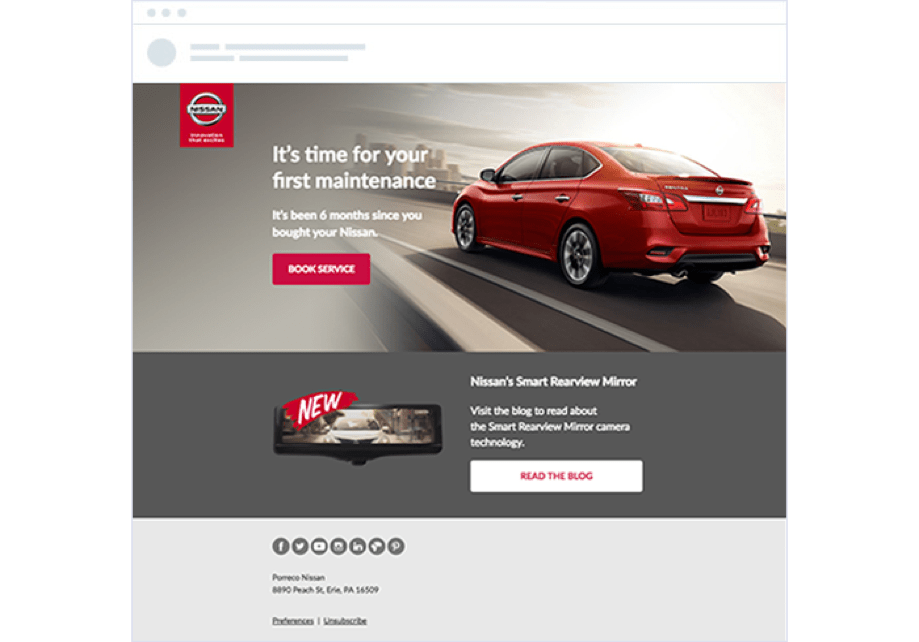
B2B
B2B buyers are a different species. They’re not as price sensitive. When your product saves the business money, time, or earns money then it’s worth it. The price is secondary.
What they’ll be evaluating is how much it’ll affect their current workflow and how hard it is to implement.
They, naturally, should be segmented differently.
Company value
Company value is the value a company has for you and the value of the company itself.
At KyLeads, companies are limited in how valuable they are to us based on our pricing plans. We operate a self-service model where potential customers come to the website, read the landing pages they’re interested in, and choose a plan. There is little to no contact needed from a human.
Customers range in value to us from a few hundred dollars a year to mid four figures. We look at the company’s value itself to determine how much they’d be willing to pay.
A company that’s doing a thousand dollars a month in revenue is much less likely to pay a few hundred dollars a month for our solution. A million dollar a month company wouldn’t bat an eye at the cost of our software as long as it solves a problem for them.
This can also be used in uncommon ways. For example, a podcast hosting company can be targeted at a specific demographic group. Instead of looking for individual creators, it could focus on attracting brands and identify them based on things like income, number of employees, etc.
Ability to make decisions
This is an important consideration because it’ll inform how you talk to the people getting your messages. Let’s say you’re selling something targeted at programmers in an organization.
It benefits the organization itself but the developers are the ones who use it. In order for it to get adopted, their managers – who’re not engaged in day to day programming work – would need to approve it.
It makes sense to tailor your messages to each group. For the programmers, you’d talk about how this helps them do their jobs better. For the managers, you’d talk about how your solution improves productivity, reduces time wasted, etc. etc.
Niche focus
The last thing you should be aware of is the niche focus of your customers. This is important whether you have one product or dozens. When you know their focus, you can tailor your messages to highlight how your product can be used.
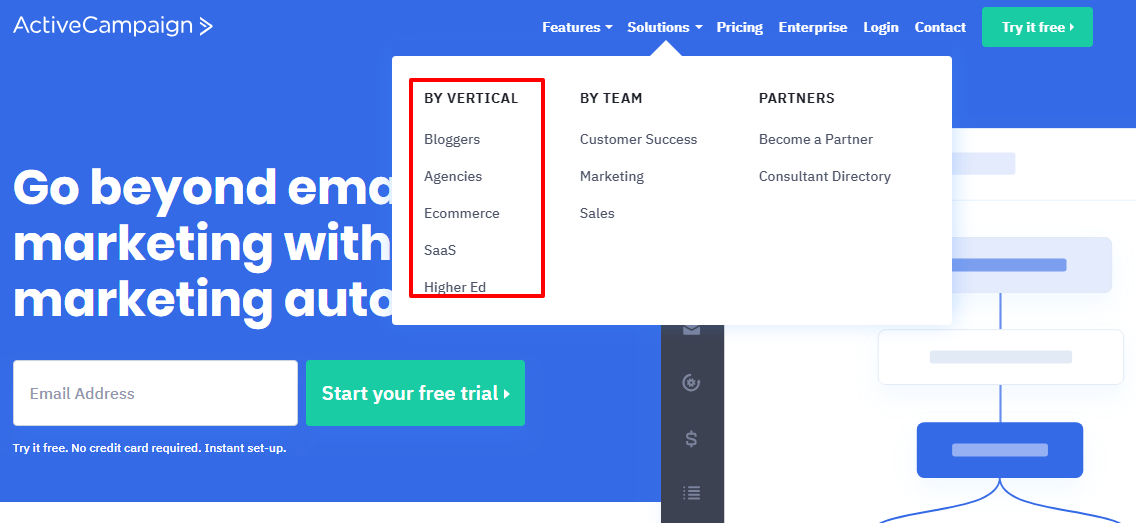
ActiveCampaign creates multiple pages for different customer segments. Each page highlights the features that would appeal to that group the most.
It allows potential customers to see the value ActiveCampaign brings to the table without getting lost in irrelevant features.
How to segment your leads
We’ve spent a lot of time discussing what market segmentation is, the benefits, and a few criteria to segment different customers. Now, we’ll look at ways to implement segmentation in your business.
Using surveys to discover the best segmentation opportunities
Every market has multiple customer profiles. They can range from dozens to over a hundred. That’s way too many segments to use in a meaningful way.
Would you know the market segments that would capture the majority of your customers?

Don’t guess. Let your market tell you what’s important to them. For this, we’ll use surveys.
There’s a question we like to refer to as the “single most important segmenting question.” This will give you almost all the insight you need to make meaningful customer segments.
What’s the biggest challenge you have in relation to X?
With a fitness example, the question would be “what’s your biggest challenge with fitness and weight loss?”
This open-ended question shows you the different groups you can segment your audience into. It also gives you a look at the exact language they use to describe their problems.
There’s is a quality aspect to the answers you’ll get. The longer the answer, the more weight you can give it. Someone may describe their situation with ten words and another describes it with a hundred words. The second person feels the pain more and should have more motivation to take action towards solving it.
Optimize for them.
This should be the first or, at worst, second question. If it’s not the first question then the first question should be something that can be answered easily.
For the remaining survey questions, ask things that you find important to your business. That could be income, preferences, age, political party, or whatever.
Send your survey out to your mailing list, advertise it to visitors on your website or set up an advertising campaign to get responses. Aim for at least a hundred participants. This will make up for any outliers you encounter.
Note: surveys sent to an external audience have completion rates of 10-15%.
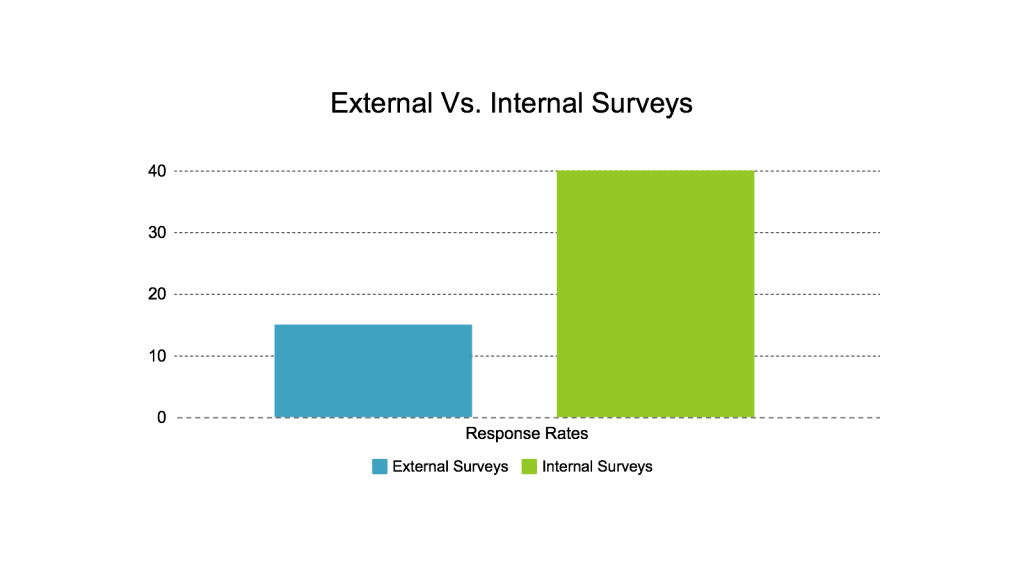
Analyzing your segmentation survey results
The most important questions you’ll ask are open-ended which means you can’t use software to pull meaningful insights.
Open a word document to copy the answers from your survey. Also, open an excel file.
Read through the answers and categorize them into different groups. At first pass, you’ll likely end up with dozens of groups.
You’ll notice is that many of the answers are similar.
If the question was “what’s your biggest challenge when it comes to digital marketing”, answers could be:
- SEO
- Content marketing
- Blogging
- Guest blogging
- Link building
- Facebook ads
- Google display ads
- Pinterest ads
- Twitter marketing
- Facebook marketing
- Instagram marketing
- Instagram ads
- etc.
From those groups, we can see a lot of them can be consolidated. SEO and link building go hand in hand. Content marketing and blogging are siblings. Google display ads, Pinterest ads, and Facebook ads are all friends that can be grouped together.
Go through the answers until you’ve consolidated your choices into three to five market segments. Any more and it’ll be difficult to take meaningful action.
When finished, you’ll have the major groups in your audience and a deeper understanding of how they describe their problems.
Check out a survey we’ve used in the past to get a better idea of the kinds of questions you can ask.
Now that you have the segments you’ll use, it’s time to segment your audience as they become leads, for that we’ll be using quizzes or opt-in surveys.
Quizzes
We couldn’t talk about segmentation without mentioning quizzes. Interactive quizzes are so effective with segmentation because they give you valuable insights while increasing engagement.
3.5x more marketers reported interactive content converts very well when compared to static content.
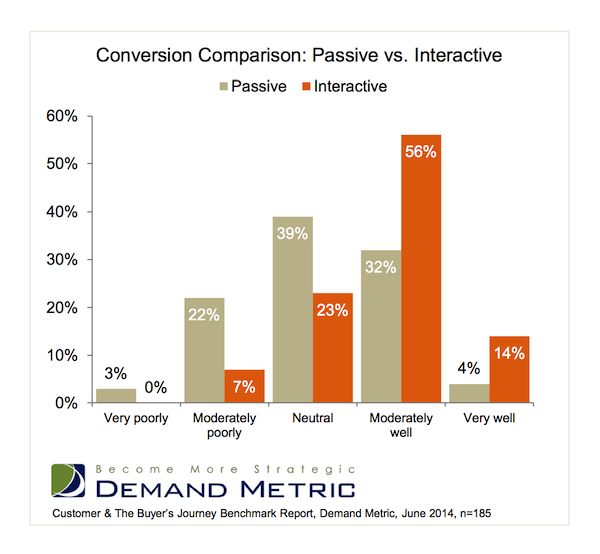
It’s no wonder the average conversion rates are over 30%.
You can ask almost any question with quizzes but it’s important to balance questions that help you segment your users with those they find interesting.
Wealthfront uses a quiz to help them better understand potential customers. They ask questions to gauge risk tolerance, investable assets, and investment goals.
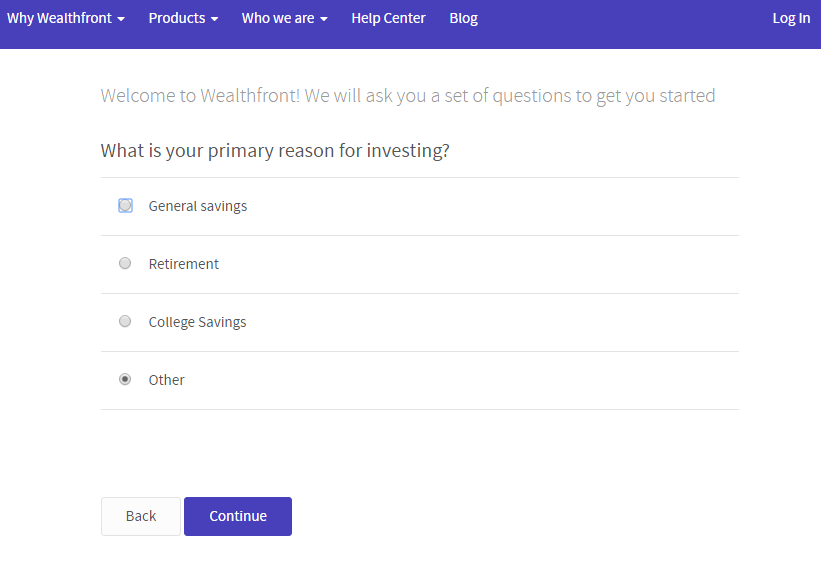
When you’ve answered all the questions, it shows you a recommended investment plan and estimated risk profile.
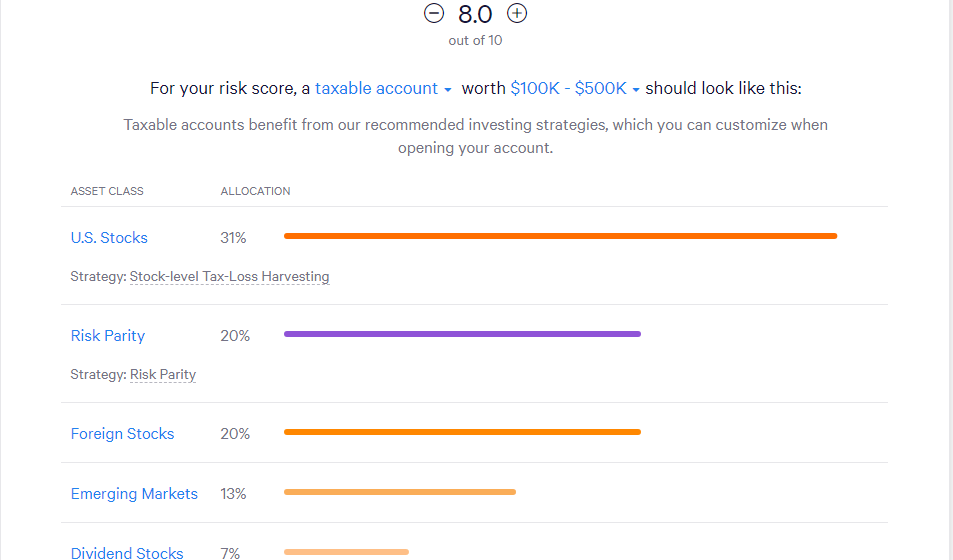
I seem to have a high tolerance for risk.
Right below that, there’s a call to action to open your account.
I’ll quickly go through how to make a quiz but be sure to refer to this post on creating quizzes for an in-depth walkthrough.
There are important things to keep in mind when creating your quizzes:
- Maintain between seven and ten questions for your quiz. Much more than that and fatigue sets in and your completion rates will start to decline.
- Begin your quiz with an easy question they can answer without much effort. Also, end your quiz with an easy and exciting question.
- After the initial question, ask your main questions (what’s your biggest challenge related to x? or which of the following best describes you?) second. The answer choices are the groups you identified through your segmentation survey.
- Use a variation of “What X are you?” “What is your X” or “what kind of X are you?” for your title. The best performing quizzes use this title.
After they’ve taken your quiz and are ready to get their results, put up a lead capture form. Use a headline for this part that lets them know what you’re going to send them personalized content based on their quiz outcome.
Inside of KyLeads, you have the ability to map each quiz outcome to a different mailing list or tag in your email marketing service.
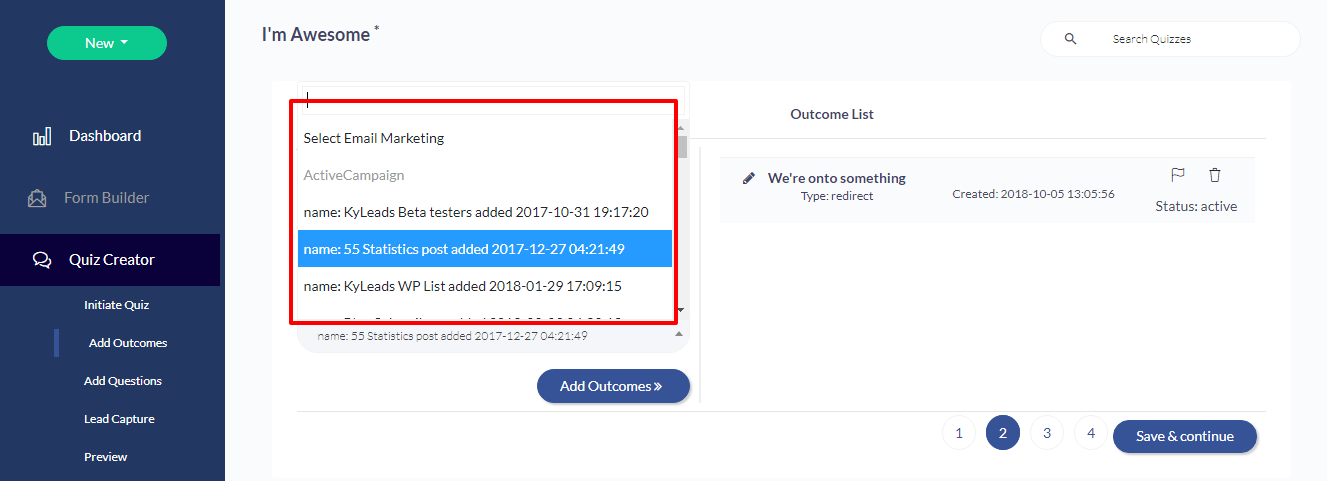
That way, when they complete a quiz, they’re automatically segmented.
From there, all you need to do is send them targeted emails in line with their quiz results.
Note: If you have a front-end offer, the quiz results page is the perfect place to pitch it.
Website behavioral activity
After you’ve added people to your mailing list, they may or not buy. To increase the likelihood of arriving at your ultimate goal – a satisfied customer – you can layer on another type of segmentation.
Website behavioral activity is a way to segment users based on the pages they visit and content they interact with. For example, if they visit a specific product page multiple times then you can assume they’re interested in it.
Set up automation rules that fire an email when someone has performed a specific action. For example, you can set up an automation rule that triggers when someone has visited a specific page 3 times. Or you can set up automation rules that trigger when someone has downloaded a certain resource.
Of course, it depends on what your goals are.
Finish Line used behavioral targeting in their email marketing to increase email revenue by fifty percent and gross returns on Facebook ad campaigns by 30%.
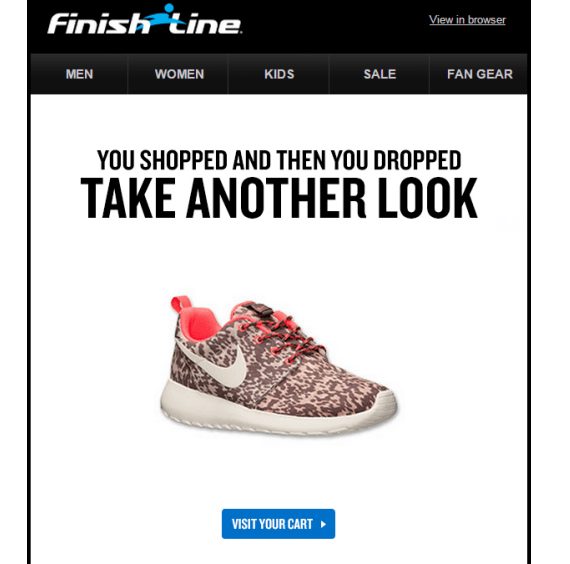
How to increase your revenue with market segmentation
All marketing segmentation in the world is useless if you’re unable to provide a positive return on investment.
Let’s look at two specific ways to increase your bottom line with market segmentation.
Specific offers for specific segments
Each of your market segments wants something different from your brand. If you have a sports apparel brand there are men and women of varying age groups. All have different goals.
There may be technical runners, people who wear brand names for fashion, or nonchalant buyers who want the best gear for fitness.
Each group would react to the same message in a different way.
Few companies use the data I’ve them given to make targeted campaigns as well as ASOS. There are two things I buy a lot from there, outerwear and shoes. It seems like every time I get an email from them, they’re letting me know about a sale for one or the other.
Here’s an email they sent me recently.
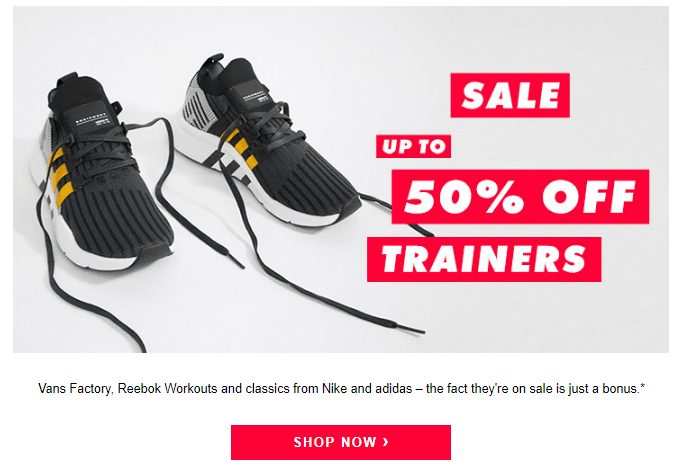

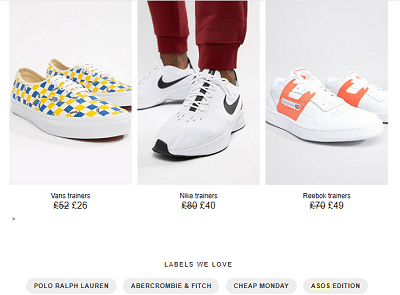
They segmented based on two variables – location and preferences. In the email, they focused on my love of shoes. 50% was too much for me to pass up.
ASOS has a large selection of shoes so it can be difficult to find what you’re looking for. This email narrowed down my selection and gave me a deal at the same time.
At the bottom, they also highlighted some of the featured brands so I could shop only those shoes. This email was super relevant and I ended up buying.
ASOS has my purchase history to work with but you can get similar results by using your customer segmentation quiz.
An Ebook marketplace could segment on the genre of books you’ve purchased in the past (Amazon actually does this).
Poo Pourri goes in a slightly different direction. They send out recommended products to their email list and gauge who clicks on what.
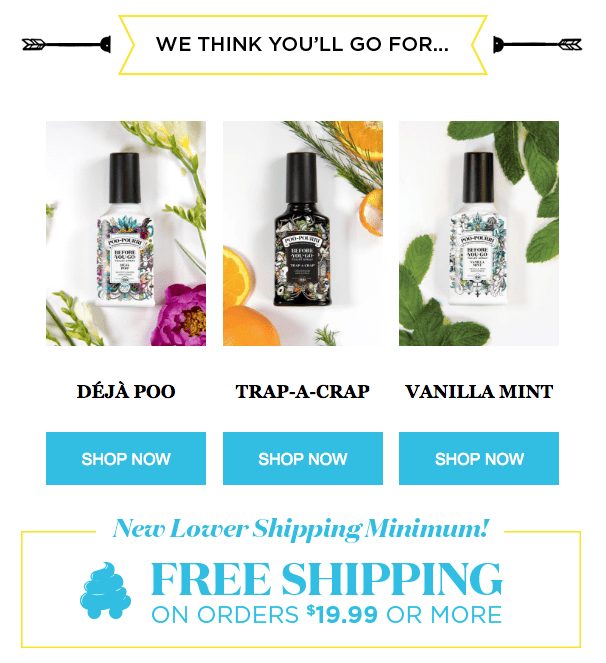
When you click on a product such as Vanilla Mint, you’d be segmented into a list of people who like it. If you don’t buy, the next email in the series also features that product.
This continues until you’ve purchased the product or shown you don’t want it. Either way, they have more data to send out targeted campaigns in the future.
Doggy Loot segments their users with a few basic questions at the point of sign up. Their homepage has been developed to capture leads with a popup and a subscribe menu option.
First step.
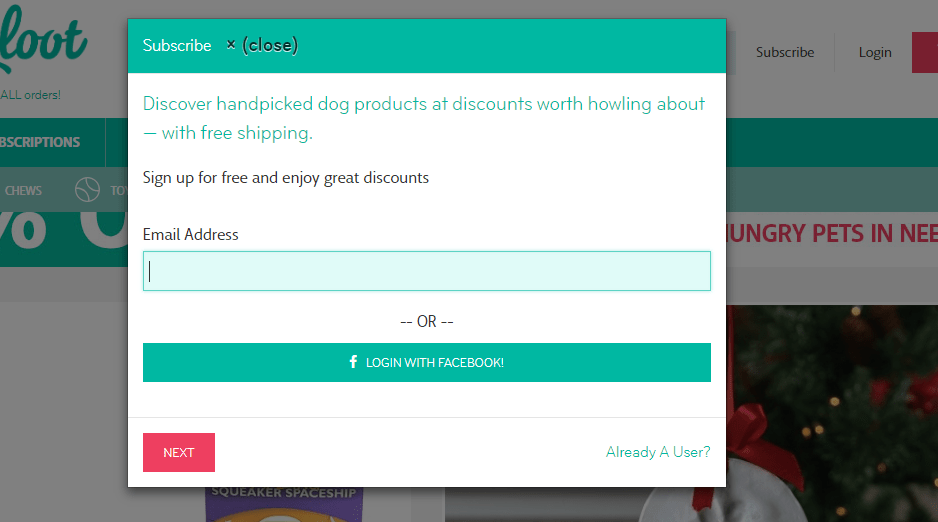
Then segmentation questions.
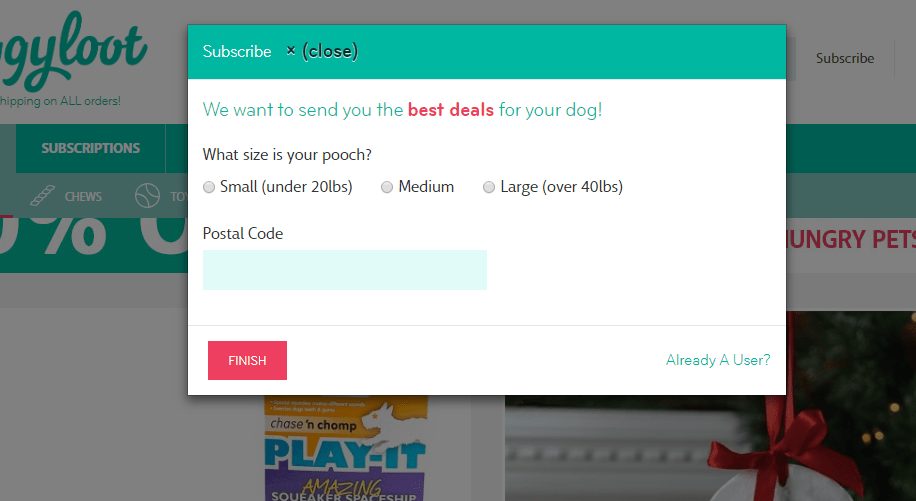 Once they have that information, the team at Doggy Loot sends out specific offers for different customer segments. That kind of tactic should be in every ecommerce email marketing plan.
Once they have that information, the team at Doggy Loot sends out specific offers for different customer segments. That kind of tactic should be in every ecommerce email marketing plan.
If you have a large dog they send you something different from the people who have small dogs.
Their open rates increased by 10.2%, clickthrough rates were 410% higher than average, and contributes up to 13% of daily total revenue.
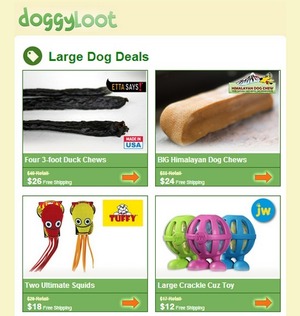
The results were so promising that they rolled out the new homepage to their entire audience and looked for more ways to segment their market.
They did this by adding a MyDogs page where subscribers could add their dogs name, breed, size, gender, and birthday. They then used this information to send even more targeted messages to their subscribers.
Their results from this email marketing campaign were even better. They had open rates of 28.1%, clickthrough rates up to 750% above average, and it contributes up to 16% of daily revenue.
Dynamic content to position general offers differently
When you get down to the nitty-gritty of segmentation, you’ll see there are too many variables (and people) to craft individual emails. To make up for that, there’s dynamic content replacement.
This is the process of sending one email but showing different content base on preferences of the receiver.
For example, you may make one email that changes slightly when it’s a male receiving it or a female. There would also be a third version when you don’t have the specific information you need.
Air New Zealand built a dynamic email campaign called “Personality Allowed.” When passengers booked flights, they would get personalized pre-flight and post-flight emails.
In the pre-flight email, they’d share information such as the weather forecast, flight crew members, and images of their destination.
In the post-flight email, they’d add a link to the MyVoice platform where Air New Zealand allows customers to update their preferences.
The results of the pre-flight email were an average open rate of 69% and a unique click-through rate of 40%. For the post-flight emails, they had an open rate of 60% and click-through rate of 40%.
Eventful dove headfirst into customer segmentation by tracking the artists their customers viewed on the website and creating personalized emails.
An algorithm would collate that information and generate a list of artists the customer would be interested in. The information was dynamically inserted into weekly emails which increased their reactivation rates by 400%.
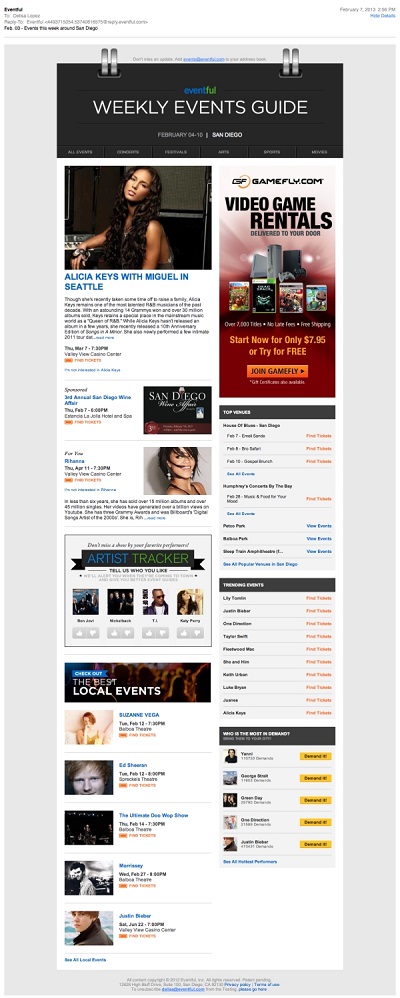
The end results were:
- 26% open rate increase.
- 97% clickthrough increase.
- 56% increase in click-to-open rate.
Conclusion
Market segmentation is one of the most powerful ways to increase your engagement and revenue. Many people believe it’s difficult to get the right data and implement it in their business.
That’s not exactly true. The key is to start from somewhere and work your way up.
Send out surveys to better understand your market
Analyze the results to find the best segments for your business.
Use an opt-in survey or quiz to segment your users and capture contact information
Determine the type of segmentation you’d like to implement (geographic, psychographic, demographic, or a combination)
Set up a few campaigns and tweak until you have a winner.
That all there is too it. You won’t be a market segmentation boss on the first go around but incremental progress will make all the difference.
Let me know how you’re using segmentation in the comments and don’t forget to share.
Market segmentation Frequently asked questions (FAQ)
What is market segmentation?
Market segmentation is the process of dividing a market of potential customers into groups or segments based on different characteristics important to you. The people grouped into segments share characteristics and respond similarly to the messages you send.
How many types of market segmentation are there?
There are four main types of market segmentation which can be further broken down based on the situation and use case.
- Geographic segmentation
- Psychographic segmentation
- Demographic segmentation
- Behavioral segmentation
What are the main benefits of market segmentation?
There are many benefits of market segmentation when It’s used properly but the most notable are:
- Better messages
- Lowered customer acquisition costs and increased revenue
- Higher customer satisfaction
What kind of businesses can use market segmentation?
In a word, all of them. They type and nuances of market segmentation change based on your industry and the type of buyer you’re serving. For example, if you’re selling to consumers in the fashion industry, what’s important to you will be different than a business selling to enterprise corporations.
Hey Daniel,
thanks for the insanely great and in depth guide on the subject. Segmentation can be time and resource consuming but it does pay off in the long run. As the market becomes more and more competitive, the old practices of mass appeal give way to specific targeting. Thus lead nurturing has become an industry field in and of itself.
Have a nice day and thank you once again for the great article Daniel
Hello Igor, thanks for taking the time to read through it. I agree, segmentation isn’t the easiest strategy in the world but it’s incredibly effective when you put in the time and energy. For anyone that’s trying to implement it, I always suggest you start with baby steps and test out with portions of your audience first as opposed to rolling sweeping changes out at once.